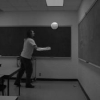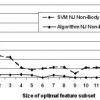114 search results - page 22 / 23 » Finding the Optimal Temporal Partitioning of Video Sequences |
IVC
2008
13 years 6 months ago
2008
A framework for the logical and statistical analysis and annotation of dynamic scenes containing occlusion and other uncertainties is presented. This framework consists of three e...
ICPR
2002
IEEE
14 years 8 months ago
2002
IEEE
We consider the segmentation of a trajectory into piecewise polynomial parts, or possibly other forms. Segmentation is typically formulated as an optimization problem which trades...
CVPR
2007
IEEE
14 years 9 months ago
2007
IEEE
Class syntax can be used to 1) model temporal or locational evolvement of class labels of feature observation sequences, 2) correct classification errors of static classifiers if ...
CVPR
2009
IEEE
15 years 2 months ago
2009
IEEE
We propose a method based on sparse representation
(SR) to cluster data drawn from multiple low-dimensional
linear or affine subspaces embedded in a high-dimensional
space. Our ...
CVPR
2007
IEEE
14 years 9 months ago
2007
IEEE
Traditional aspect graphs are topology-based and are impractical for articulated objects. In this work we learn a small number of aspects, or prototypical views, from video data. ...


